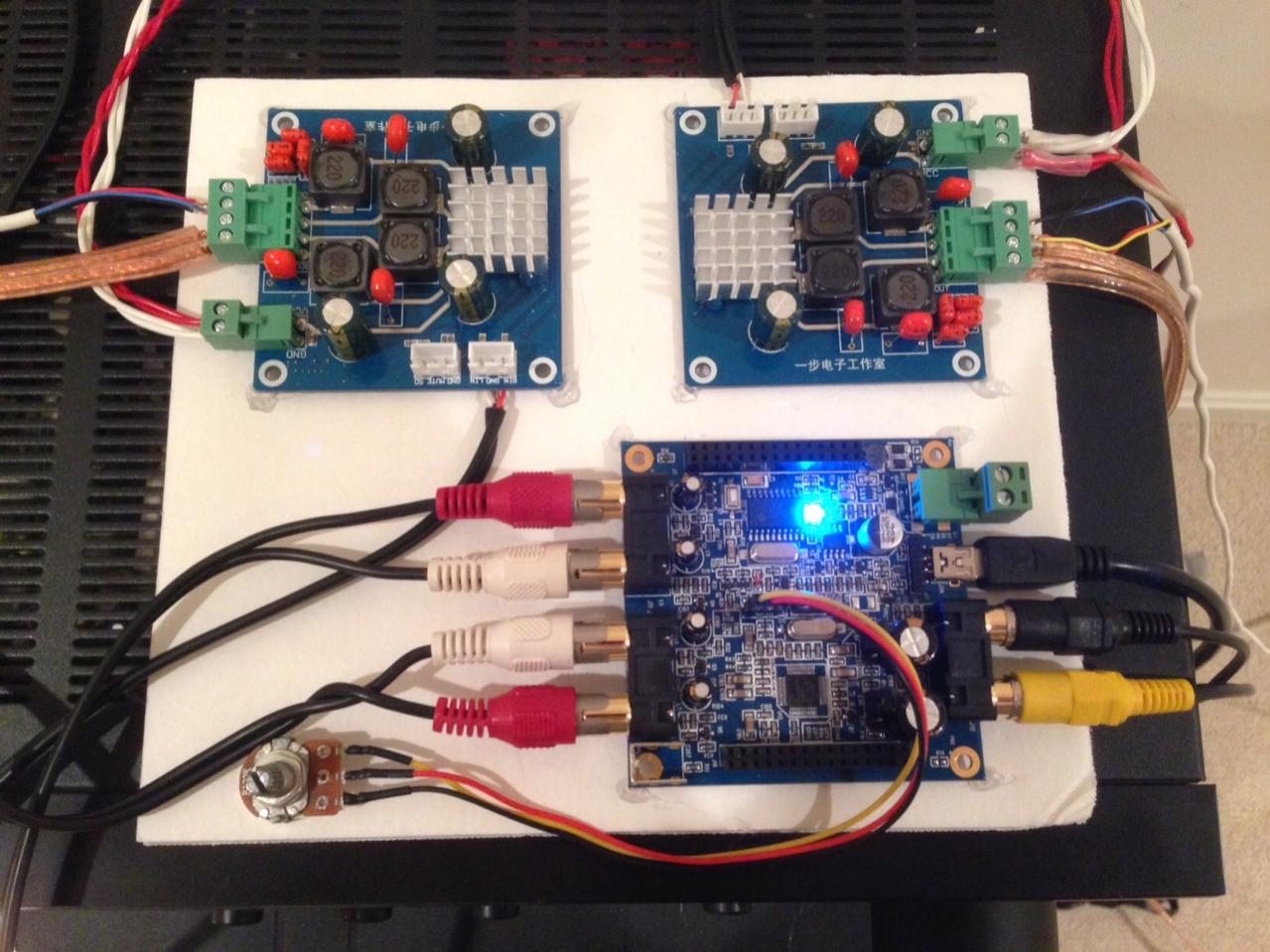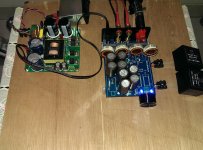Honest question: if you have enough capacitance to meet all your power needs (i.e. caps are always filled faster then they are drained), does your power supply really make any difference? For someone like me who's background is in software, is it correct to think of a capacitor bank as a "power buffer"?
The question isn't really about caps meeting power needs - the caps are always going to be filled faster than they're drained over the long term or it means your PSU lacks guts. The real question is 'how much does the power supply sag?' when listening. Ideally the caps are meeting the short-term needs for power and your power supply meets the longer-term needs. Thus the caps have the most influence over the HF SQ and the power supply starts contributing its 'sound' at lower frequencies. The more caps on the supply close to the TPA3116 the lower the frequency where the PSU begins to influence the sound.
This is excluding common-mode noise issues which are a separate matter entirely.
Back in post 5921 I was whining about the power-on thump on my Sure board. Turns out it was the tube pre-amp. If I turn the volume all the way down on it, I don't get the power-on thump. Yeah!
I don't know if this is the right place to post but:
I would like to use my YJ blue 3116 to power a Mark Audio Alpair 7.3 in a FAST system. I would like to high pass it (1st order) and was wondering if the input capacitor could simply be changed using the Ti datasheet (page 15) http://www.ti.com/lit/ds/symlink/tpa3116d2.pdf
If so it would mean I could just change the input cap to ~0.035uF to give a crossover frequency of ~ 151Hz and it would be cheap and simple. Please let me know your thoughts if this is ridiculous or sensible.
Andy
I would like to use my YJ blue 3116 to power a Mark Audio Alpair 7.3 in a FAST system. I would like to high pass it (1st order) and was wondering if the input capacitor could simply be changed using the Ti datasheet (page 15) http://www.ti.com/lit/ds/symlink/tpa3116d2.pdf
If so it would mean I could just change the input cap to ~0.035uF to give a crossover frequency of ~ 151Hz and it would be cheap and simple. Please let me know your thoughts if this is ridiculous or sensible.
Andy
Yep you can do that - though bear in mind the input impedance tolerance is +/- 20%. If you don't mind your XO point not being particularly accurate (your cap tolerance will add to that figure), you're good.
I see many talking about OSCON caps, do you propably mean this capacitor family: 20SEPF560M Panasonic | Mouser
Are those for example good caps for upgarding the on-board filtering caps on Sure 3116 board? Is the 5mm lead spacing correct (I dont have the boards yet myself)? Something better sounding caps out there at +/- 100% price range?
Are those for example good caps for upgarding the on-board filtering caps on Sure 3116 board? Is the 5mm lead spacing correct (I dont have the boards yet myself)? Something better sounding caps out there at +/- 100% price range?
Thanks abraxalito.
I can probably live with the tolerance as the active low pass filter I'm using to 'sub' has an adjustable frequency cut off so I should be able to adjust to suit.
I can probably live with the tolerance as the active low pass filter I'm using to 'sub' has an adjustable frequency cut off so I should be able to adjust to suit.
WLX vs. SMSL amps
Thanks to the efficiency of the EPacket program from the China and U.S. Post Offices, I quickly received the Breeze Audio 3116 amp based on the WLX board. So I have been able to compare it to the SMSL SA-60 amp I already have on hand (a built amp based on the 3116).
As I've written here, I've been extremely impressed with the sound quality of the SMSL SA-60. Within its power limits (which are not always enough for hard-to-drive speakers), the SA-60 has qualities that I normally hear in high quality tube amps, including a naturalness in harmonic structure, excellent imaging, and a highly musical presentation. In addition, it has better control of the speaker than most tube amps, resulting in excellent transients and bass.
The SA-60 is the only 3116 amp I've heard up until this point, until the WLX-based amp arrived.
The WLX-based Breeze amp is not at all in the same league as the SMSL amp. It is not as good to my ears. It suffers from hardness and brashness in its overall character (noise contamination?), slowness in transient response, lack of bass, limited dynamics, and an overall less than natural musical character. Reviewing comments on this forum about the WLX board, it appears to be an incomplete implementation of the TI evaluation board for the 3116, lacking in particular parts that help limit noise contamination of the audio signal from the high frequency switching components. It probably also has a standard inexpensive pot in the audio path, that likely also limits the quality of the audio signal, which I plan to remove.
So my thought now is to mod the WLX board to see if it can be brought up to the level of the SMSL amp. I'll post again when that's done.
Sure has told me that they plan to come out with their own built amp, scheduled for January 2015. That should be an interesting comparison with the SMSL amp.
The great thing about these 3116 amps is that they are reasonably priced so that it's easy to purchase and compare them without a big loss if they are below par or some unfortunate fatal accident befalls them during the modding process.
My one reservation about the SMSL amp remains - that if used as a basic amp rather than an integrated amp, the automatic volume control reset function interferes, because upon each turn off the volume is reset to a very low level and must be manually turned up again for use. As good an idea as this may be for use as an integrated amp to protect one's speakers and ears, it makes it difficult to use several of these amps in a multichannel system.
Hi I guess you don't mean the simple Breeze 2.0 channel amp ?
I see many talking about OSCON caps, do you propably mean this capacitor family: 20SEPF560M Panasonic | Mouser
Are those for example good caps for upgarding the on-board filtering caps on Sure 3116 board? Is the 5mm lead spacing correct (I dont have the boards yet myself)? Something better sounding caps out there at +/- 100% price range?
Hi Legis,
This family is OK, use this ref : 25SEPF330M you must go for higher voltage than 20v if you plan to use 20v PSU wich is recommended. 330 mF is enough if you use four or six caps on the board. I've put four on my boards producing the same value than the six originals caps.
By the way have some people tested Sure TPA3116 boards and miniDSP 2x4 combo to drive active speakers ?
BR
Last edited:
Hi Legis,
This family is OK, use this ref : 25SEPF330M you must go for higher voltage than 20v if you plan to use 20v PSU wich is recommended. 330 mF is enough if you use four or six caps on the board. I've put four on my boards producing the same value than the six originals caps.
By the way have some people tested Sure TPA3116 boards and miniDSP 2x4 combo to drive active speakers ?
BR
Yes, the Ybdz and miniDSP are a great combo!

Whats the ripple/noise (mv)?
Spec sheet says 19mV @ 1A. I might try this for my DUG boards @ 20V. Thanks for the report!
BK
Hi I guess you don't mean the simple Breeze 2.0 channel amp ?
***
Ebay auction titled "Latest-HIFI-2-0-Stereo-Output-Digital-Power-Amplifier-TPA3116-50Wx2-by-WLX New"
Here's a link:
Latest HiFi 2 0 Stereo Output Digital Power Amplifier TPA3116 50WX2 by WLX New | eBay
Spec sheet says 19mV @ 1A. I might try this for my DUG boards @ 20V. Thanks for the report!
BK
The more you go up in Amps it doubles or triples unless its debugged.
The one I got in from China today, had them debug it down to 55mv, that other one was 76mv. Im at 24V 5A. It sounds better then the linear psu at 14v.
Go figure...
The question isn't really about caps meeting power needs - the caps are always going to be filled faster than they're drained over the long term or it means your PSU lacks guts. The real question is 'how much does the power supply sag?' when listening. Ideally the caps are meeting the short-term needs for power and your power supply meets the longer-term needs. Thus the caps have the most influence over the HF SQ and the power supply starts contributing its 'sound' at lower frequencies. The more caps on the supply close to the TPA3116 the lower the frequency where the PSU begins to influence the sound.
How about another analogy: say you have a big hose that supplies drinking water (assume multiple people can simultaneously drink from the hose). In this analogy, the hose is the DC supply, and the people drinking water are the amp. Now, add in a big bucket between the hose and the people, this is a capacitor.
If you have too small of a bucket, not everyone will be able to drink exclusively from the bucket---the excess water demand will force some people back to the hose. But with a big enough bucket (or few enough thirsty people), everyone drinks exclusively from the bucket, never from the hose.
At least in my drinking analogy, with a big enough bucket, the people never even know about the hose. As long as the bucket refills quickly enough, the "real" water source doesn't even matter, e.g. hose or rainwater, or someone dumping in water stolen from another bucket. In other words, to those people, the bucket is the water supply.
Does this analogy work?
A few posts back, irribeo mentioned the "AC1103" PBTL tpa3110 board, along with a Taobao link. Taobao scared me away, but I now it's listed on AliExpress: TI digital amplifier board / PBTL output power 30W! / Mono. If the link doesn't work, try searching for "30W PBTL" or "AC1103".
The only thing I don't understand is the price, it says, "US $106.25 / Bag". What's a bag? I tried contacting the seller, no reply. I assume a bag means more than one, or at least I hope it does at that price. Anyone have any experience with this?
The only thing I don't understand is the price, it says, "US $106.25 / Bag". What's a bag? I tried contacting the seller, no reply. I assume a bag means more than one, or at least I hope it does at that price. Anyone have any experience with this?
- Home
- Amplifiers
- Class D
- TPA3116D2 Amp


